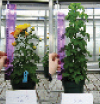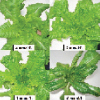
Features
Inputs
PGRs
PGRs and LEDs in U of G studies
August 27, 2008 By Dr. Theo J. Blom Instructor University of Guelph
Suggestions from growers often find their way into the classroom labs
Suggestions from growers often find their way into the classroom labs
Introduction: This is the sixth year that I have assembled the
abstracts of the students in the greenhouse crop production course.
This course is a prerequisite for obtaining the undergraduate B.Sc.
Agr. degree, and is usually taken in the third year. Besides the
(inspiring?) lectures, the students are also fulfilling a lab portion,
which usually focuses on a research topic. Thanks to those growers who
have contacted me with possible research topics during the year. Many
projects deal with studying the effect of an environmental factor on
the growth and/or development of a plant/species. It allows the student
to get an idea of what research is all about and they get to work with
plants in a real setting. The results may not be conclusive, although
we often get an indication on where the research is heading. The
following are five short summaries from the winter semester of 2008.
Photoperiod control by LED lights using cycling lighting in chrysanthemums
By Christine Tobin and Shannon O’Dwye
Growers often apply supplemental lights to create long days for
chrysanthemum crops in order to produce larger plants – by maintaining
vegetative growth – and prevent flower induction. Incandescent lights
are currently a popular choice among growers. However, a significant
cost savings may be possible with the use of light-emitting diodes
(LED) lights. This is because they provide an average electrical
efficacy of 50 lumen/W compared to traditional incandescent lights that
only provide 15 lumen/W.
For this experiment, red LED lights (wave length ~ 630 nm) were used in
a cyclic pattern. This consisted of six minutes “on” and 24 minutes
“off” each night, from 10 p.m. until 2 a.m. The lamps were in a linear
bar (~ 80 cm long) positioned at the short side of one bench and thus
created different intensities along the length of the bench. The plants
(rooted cuttings in 10-cm pots) were set up in nine different light
intensity treatments, ranging from 0-5.5 µmol/m²/s. The results showed
that plants remained vegetative above 2.8 µmol/m²/s while plants below
1.7 µmol/m²/s became generative.
This research demonstrated that red LED lights using cyclic lighting
were effective in controlling the photoperiodic response of
chrysanthemums.
Figure 1. Low LED light intensities from 0 to 1.7 µmol/m²/s resulted in
generative chrysanthemums (left), while light intensities from 2.8 to
5.5 µmol/m²/s maintained vegetative plants (right).
 |

|

|
| Figure 1 | Figure 2 |
Figure 3 |
 |
 |
|
| Figure 4 |
Figure 5 |
The effect of calcium concentration on leaf tipburn of hydroponically grown lettuce
By Brad deJong and Etienne Papineau
Leaf tipburn is a physiological disorder commonly found in lettuce production.
Two butterhead lettuce cultivars (‘Pybas Red Butter’ and
‘Buttercrunch’) were grown hydroponically in an NFT system using a
Hoagland solution. Four concentrations of calcium (0, 1, 2, and 4
mmol/L) were compared in order to evaluate the effect of calcium on the
incidence of leaf tipburn. The results (Figure 2) showed that reduced
calcium levels resulted in increased leaf tipburn. By reducing calcium
concentrations below 2 mmol/L, or 50 per cent of the recommended rate, significant increases
in tipburn incidence and substantial reductions in plant leaf area and
fresh weight were observed. ‘Buttercrunch’ was more susceptible to leaf
tipburn than ‘Pybas Red Butter.’
Figure 2. The effect of Ca++ concentration on the incidence of leaf tipburn of ‘Buttercrunch’ lettuce.
Single and split applications of the plant growth regulator, Sumagic™,
at varying concentrations on Lilium longiflorum ‘Nellie White’
By Diana Chapman and Laura Maurice
Sumagic™ (a.i. uniconazole) is a plant growth regulator widely used in
the industry to keep Easter lilies within marketable target height. We
tested the effectiveness of foliar and drench split applications
(double or triple split versus a single application). All applications
were applied at the end of January. The total amounts of active
ingredient per pot were kept the same. All plants treated with Sumagic,
both foliar or drench, showed lower plant height compared to the
control. Plants treated with a drench at 1.8 mg of a.i./plant were
about one-half the height of the control. Leaf senescence was
particularly prominent in the drench treatments. Overall, there were no
conclusive results that suggested split applications were more
effective than a single application.
Figure 3. The effect of drenching Sumagic at 1.8 mg of uniconazole on
Easter lilies. Left to right: control; single application (180 mL @
10ppm); two applications at 5 ppm; three applications at 3.33 ppm. The
split treatments were applied 24 hours apart. Note the effect of
excessive dosage on the droopiness of the leaves.
The effect of frequency of irrigating cold water on the height of Easter lilies
By Louise Robertson and Jacob Yantzi
Cold-water applied directly to the Easter lily shoot apex reduces stem
elongation. Different cold water irrigation frequencies were evaluated
to determine their effect on height. Emerged potted “Nellie White”
Easter lilies were irrigated with cold water nutrient solution
(375 ppm N) applied directly onto the shoot apex using three treatment
frequencies of 100 ml twice per week, 200 ml once per week, and 400 ml
biweekly. The nutrient solution temperatures ranged between 0.5 and
1.9ºC. The control plants were treated with ambient (20ºC) nutrient
solution to the shoot apex. The treatments covered a six-week period
from Jan. 18th to March 6th. The results showed that as the frequency
of cold water application increased, the plant height decreased. Both
the 100 ml twice per week and the 200 ml once per week cold water
treatments were significantly shorter than the controls. Water
temperature did not affect bud abortion or the number of yellow leaves,
and there was no significant delay in bloom.
Figure 4. The effects of cold water frequency applied from Jan. 18
until March 3 on Easter lilies. (From left to right) control; 100 ml
twice a week; 200 ml once a week; and 400 ml biweekly using 2ºC water.
Plants were chosen as an average representation of each treatment on
March 3,
2008.
The effects of pH and sucrose on the flower longevity, bud abortion and water uptake of Asiatic hybrid lilies
By Chris Duyvelshoff and Carson Tiede
Floral preservatives generally contain a carbohydrate source and one or
more bactericides to increase vase life. The effects of sucrose and
acidity in vase solutions on cut Asiatic hybrid lilies were evaluated
in two cultivars. Two stems, one of each cultivar, were placed in vases
with or without a 3 per cent sucrose solution at pH levels of 4, 7 and
10. Water uptake was significantly reduced in the vase solutions
containing the 3 per cent sucrose solution regardless of pH. The flower
longevity of individual flowers, as well as the ratio of opened to
aborted buds, was not affected by sucrose or pH level. Sucrose addition
was found to cause rapid yellowing of the leaves within the first five
to seven days after placement in the vase solution. Common florist
practices use sugarless solutions or defoliate lilies to avoid this
problem. ■
Figure 5. Overview of the vase solutions (from left to right): pH 10 +
0% sucrose (S), pH 10 + 3% S, pH 7 + 0% S, pH 7 + 3% S, pH 4 + 0% S and
pH 4 + 3% S. Black bars indicate the level of solution remaining in
vases after two weeks.
Print this page